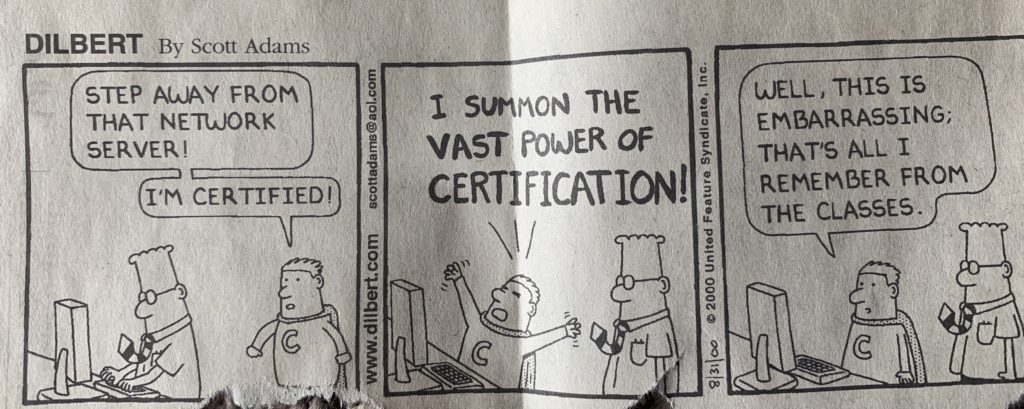
The evolution of technology is ever increasing. It is important for IT professional to adapt quickly to these changes. Unfortunately, learning is something than takes time and focus. Learning requires repetition. These topics are too complex or broad to absorb by sitting through a class or watching an online training session.
I recommend first narrowing your focus by placing technology topics into three categories:
- Foundational Knowledge – These are the fundamental subject areas that are the foundation of your current focus areas. It is important to review and reinforce what you have already learned and to fill knowledge gaps. Think of this as maintaining and sharpening your toolset.
- Conversational Knowledge – These are the topics that help you stay informed on related technologies in order to broaden you industry knowledge. This may include industry news, offerings from other vendors, related technology, and other applications used or sold by your organization. Think of this as increasing the size of your toolbox.
- Evolutionary Knowledge – These are the topics that will help you transform and grow. These are the topics that will make you relevant, marketable, and prepared for future opportunities. Think of this as replacing your existing tools with shiny new tools.
Prioritize your focus based on your current situation. Developing conversational knowledge should never exceed 25% of your focus. If you are new to a role or have let your skills get rusty, you may want to prioritize developing foundational knowledge. If you know your foundational topics well then I would prioritize evolutionary topics.
The point I want to make is that there isn’t enough time in the day to know or learn everything. Begin by trying to set aside 4-5 hours per week for education. Then take the time to categorize and prioritize where you will spend that time. All the while taking a balanced approach to maintaining your current skillset, broadening your scope, and transforming your skills for your next big adventure.
TIP: If you are struggling to find 4-5 hours per week to study, start by acknowledging that personal development is your responsibility. Your employer may provide you with resources but true growth requires commitment and time outside of the office. Also, look for distractions in your personal life than can be minimized or eliminated.
TIP: Know that keeping momentum is harder than starting from a resting position. Try to maintain a focus on continuous learning to avoid hitting a rut. The longer you allow yourself to rest the harder it will be to restart the flywheel. Keep a steady pace to avoid burnout and just keep the ball rolling.
The remainder of this article will focus on sharing my approach to deep dive learning. I reserve this level of focus for foundational and evolutionary study topics. I am a big fan of certification exams. The exam objectives create a learning framework and the exam itself provides a benchmark. Certifications provide a goal that tells you what to learn and when to move on to something new. I recommend taking a similar approach even if you are not studying for an actual exam.
I like to think of studying for an exam or learning a new topic as creating a shadow box. If you are not familiar, a shadowbox is a display box that often has dividers used to display collectibles. These boxes are often designed to be hung on a wall and vary widely in the shape and number of items displayed.
In order to create a shadowbox you first need to understand the dimensions. The number, size, and shape of the items define the framework (the overall size and the positioning of the dividers). Most collections are too large to be displayed in a single shadowbox. Your next step is to identify the objects to be displayed, the layout, and grouping. Finally, you put it all together and make any final adjustments once the completed arrangement can be seen.
Similarly, when learning a new topic I recommend starting by defining the framework or a high level introduction. This is your training videos or classroom experience. Training videos and classrooms are useful for gaining an understanding of the scope and framework of the material or subject. Few people are capable of mastering a topic after taking a class or watching a video without putting in some extra effort. Making an early attempt at an exam (real or practice) is also a great way to build a mental framework. Your framework-level understanding will enable you to describe and visualize the scope and outline of the material.
Note: If you are developing conversational knowledge a class or online training session alone may be sufficient.
Next, find the documentation. You need to take your conceptual framework and begin filling in the boxes. Most certifications are based on clearly defined learning objectives. Exam prep books are often framed around these same learning objectives. If you prefer the official documentation for a deeper understanding, you can usually find reference material that will link the exam objectives to specific vendor documentation. Reading the core documentation is preferred if you are pursuing mastery (and free) but an exam prep book will work.
I often hear IT folks say something like “I learn by doing not reading” but nobody achieves mastery without digging into the documentation. This is equivalent to a mechanic saying, ” I am good at fixing things but I don’t like getting my hands dirty”. There are simply too many details and explanations that are not presented in a UI or CLI. When it comes to exams you will encounter terminology and foundational concepts that cannot be learned with a hands-on only approach. When you are troubleshooting or training others, your knowledge of these finer details will be put to the test. Be prepared to dig in and get your “hands dirty”.
The goal of reading official documentation or an exam prep book is to gather data for what I call the cook-down process. The main idea behind a cook-down is to take a large body of information and cook it down into a much smaller, easy to consume portion size. I prefer to use digital documentation due to the easy of copy-paste and other note taking tools. Taking hand written notes is effective but slow.
Read through the documentation with one simple goal to minimize the words into notes. Reduce each meaningful paragraph into 1-2 sentences that summarize the information. Focus on making it possible to review the material in a fraction of the time by eliminating unnecessary words. You can also omit subjects that you have previously mastered. I highly recommend avoiding simply highlighting the pages of a book. You should be reducing the book or documentation by 90-95%. Referring back to the full documentation slows your ability to review the material compared to a stand-alone set of notes.
TIP: Reading technical documentation does not have to be an intensely focused activity. I often skim-read looking for useful bits of information and to gather enough information for a mental picture. For example, skim a paragraph or page and ask yourself if you understood the information and whether there were and finer details that can be noted to jog you memory of the topic. If the message is unclear you can always start over with more focus.
The next round is practical. Use online labs, demos, or free subscriptions to run through scenarios representing the exam objectives. Use this to reinforce your studies and look for gaps. Each step, command, or UI option should either trigger a positive recognition of your previous training or identify areas that you need to revisit. For example, as you are running through the install steps you immediately recognize most of the settings listed and have a fair understanding of their purpose and impact. You will also see settings that you don’t recognize or that you cannot explain (gaps). Try verbally walking through the configuration scenarios or application features; explaining each as if you were instructing a student. Imagine someone looking over your shoulder asking, “what does that setting do and when would it be used”?
The final cook-down step is review and memorization. Go back through your notes. Try to visualize the practical scenarios as you read. The main goal here is to highlight or identify concepts that require memorization. I prefer to use flashcards and record these topics in the form of a quiz question. I usually only need to revisit these cards 2-3 times since the process itself helps to lock in those finer details.
It is advisable to run through 1-2 practice tests if you are preparing for an exam. These can be time consuming. I personally avoid spending too much time on practice tests. A good practice test will introduce you to the exam question format. Learning to avoid exam-specific mistakes is very important. I recommend using practice test software that gives you an explanation after each question. Take a moment to review the explanations on why each answer was wrong or right. Sometimes understanding why an answer is wrong is just as important as understanding the right answer.
TIP: One way to maximize practice tests is to skip to the end and fail the test. Then go back and review each question and the explanation.
On exam day my focus is on rest and clearing my head. I will skim my notes and run through my flashcards once or twice. I avoid taking practice exams on the same day to reduce exam fatigue. Immediately following the exam I will jot down areas where I felt challenged (pass or fail). This last step is especially helpful if a retake is needed. Some exams can throw you for a loop the first time no matter how much you study. Those details seem to slip into oblivion pretty quickly. Just remember that any notes on exam details are for your private use.
The outcome of the cook-down process is that you now have a personalized resource that you can reference later. In many cases you may not have the opportunity to apply your new knowledge immediately. At some point in the future when you need to maximize the time invested in you education, you can review your notes to reinforce what you may have forgotten. For example, prior to taking a related exam, before an interview, before teaching a class, before a meeting, or before a customer engagement. The goal is not only to pass the test but to retain that information as a resource that you can tap into at a future date to impress your boss, peers, and customers.
Let me close by summarizing the cook down study method. Start at a high level with a class or video to get the big picture, read and reduce the study material to a manageable set of notes, and break those notes into flashcards for memorization. When studying for exams follow up with a few practice tests. Book your exams early for motivation, be prepared to retake if needed, and don’t lose your momentum (start that next exam soon after).
Imagine that you are tasked with adding a 2 inch layer of paint to a wall. Lets say it takes 1,000 coats of paint on average to form 2 inches. There are no shortcuts; you will have to paint layer after layer. Layering too thick could lead to waves or bubbles. Painting too thin might cause you to give up under the strain of the extra work. The best approach is 1,000 even layers, each carefully applied, with ample time to dry in between. Mastery of information requires a similar repetitive process of placing one layer after another. No single book or program results in mastery; it is the combination of 1,000 layers.
